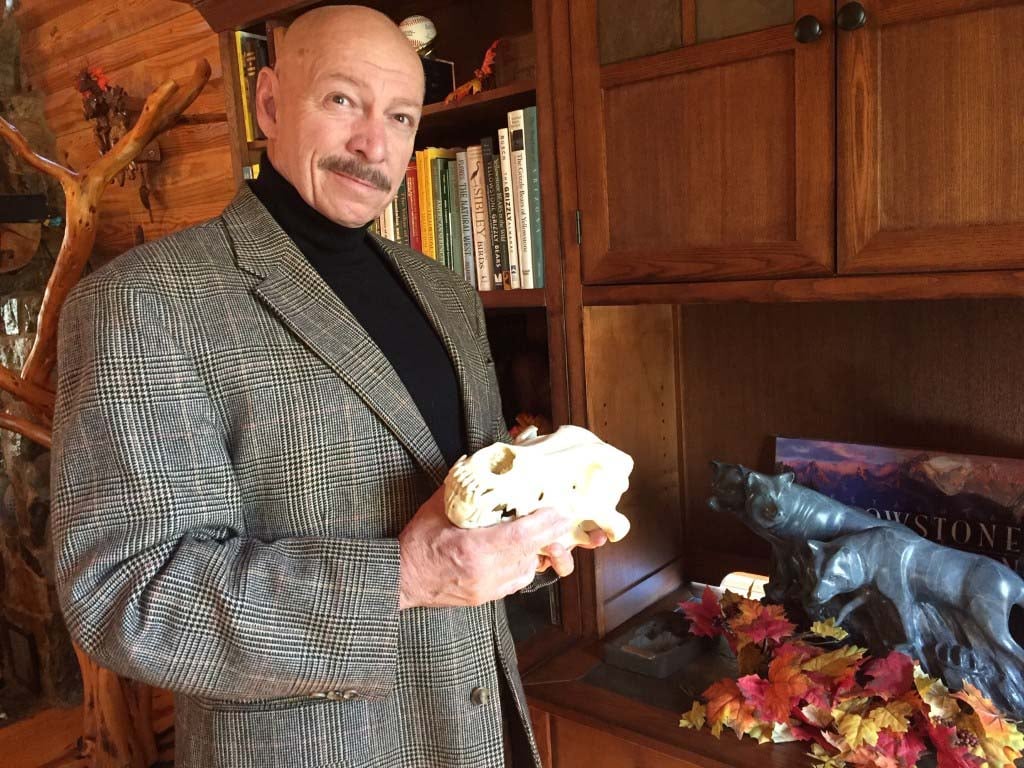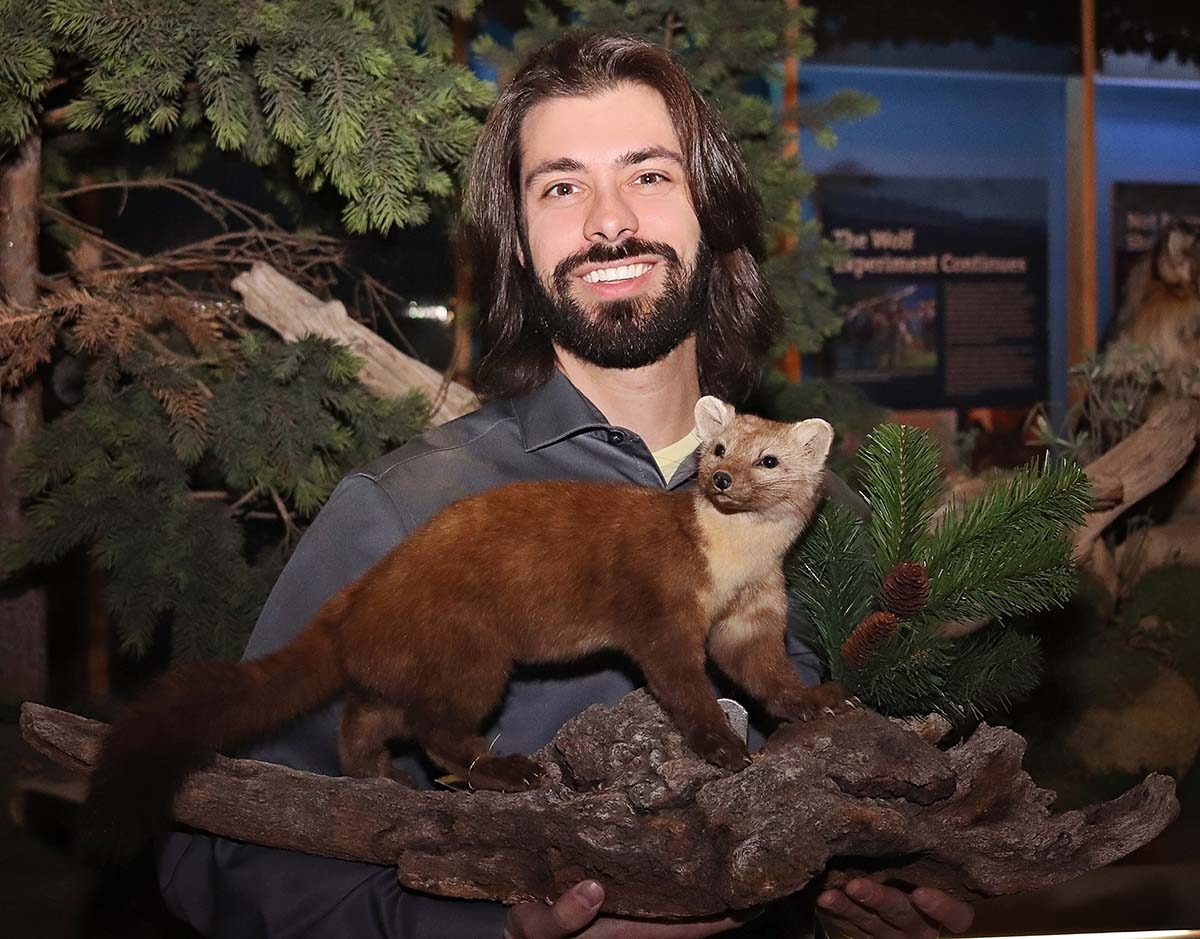Draper Natural History Museum staff
Meet the staff of the Draper Natural History Museum at the Buffalo Bill Center of the West, Curator Corey Anco, Curatorial Assistant Amy Phillips, Live Raptor Program Manager Melissa Hill, Live Raptor Program Assistant Manager Brandon Lewis, and Research Assistant Larry Oliveria. Previous Curators of the Draper Museum include Dr. Charles R. Preston and Nathan Doerr.

Corey Anco
Willis McDonald IV Curator of Natural Science
Corey Anco was promoted to Willis McDonald IV Curator of Natural Science for the Draper Natural History Museum in November 2022, after having served as Interim Curator since January of 2022. He joined the staff in August of 2017 as an Assistant Curator. Before coming to the Draper, Corey pursued opportunities with the U.S. Forest Service, U.S. Fish and Wildlife Service, U.S. Geological Survey, and National Geographic Society’s Big Cats Initiative. Fieldwork experience ranges from tallgrass prairies of the Midwest and tundra of the Alaska Peninsula, to immersion in Neotropical rainforests in Belize and the concrete jungle of New York City fostering a comprehensive exposure to wildlife responses following habitat disturbance. Anco also has extensive experience in teaching ecology and communicating science to youth groups, high school, and undergraduate students with the Wildlife Conservation Society. He is a Certified Interpretive Guide through the National Association for Interpretation.
Academically, Anco earned a Bachelor of Science from Lewis University, Master of Environmental Management from Duke University, and Master of Science in Biology from Fordham University. He also holds certifications in geospatial analysis and chemical immobilization of wildlife. While attending Fordham University, Anco studied the phylogeography (geographic distribution of genetic lineages) of African leopards (Panthera pardus) using mtDNA he recovered from leopard skulls in the American Museum of Natural History collections. This research provided a much needed and updated reference benchmark of genetic diversity of the African leopard.
Anco’s approach to the long-term preservation of wildlife interweaves themes of ecosystem rewilding, partnership building, and responsible land stewardship. His interest in joining the Draper Natural History Museum stems from his experience in working with museums and their collections to inspire and promote understanding, appreciation, and conservation of wildlife and wildlands. When he’s not in the museum, Anco can be found in the kitchen cooking up a storm, splitting wood, planning a hike in the GYE, or beside a fire with a guitar.
Publications:
Anco C, Kolokotronis SO, Henschel P, Cunningham SW, Amato G, Hekkala E (2016). Historical mitochondrial diversity in African leopards (Panthera pardus) revealed by archival museum specimens. Mitochondrial DNA Part A: DOI: 10.1080/24701394.2017.1307973
Jacobson AP, Gerngross P, Lemeris Jr JR, Schoonover RF, Anco C, Breitenmoser-Würsten C, Durant SM, Farhadinia MS, Henschel P, Kamler JF, Laguardia A, Rostro-García S, Stein, AB, Dollar, L (2016). Leopard (Panthera pardus) status, distribution, and the research efforts across its range. PeerJ 4:e1974. DOI: 10.7717/peerj.1974
Jacobson AP, Gerngross P, Lemeris Jr JR, Schoonover RF, Anco C, Breitenmoser-Würsten C, Durant SM, Farhadinia MS, Henschel P, Kamler JF, Laguardia A, Rostro-García S, Stein, AB, Dollar, L (2016). Profiles for leopard (Panthera pardus) range countries. PeerJ 4:e1974. DOI: 10.7717/peerj.1974/supp-16
Amy Phillips
Curatorial Assistant
Amy Phillips joined the Draper Natural History Museum from the Meeteetse Museums where she served as Director of Education and Programs. While at the Meeteetse Museums, Phillips served as co-Principal Investigator on the “Bison of the Bighorn Basin” Project. The project sought to learn about bison morphology and ecology in the geographic Bighorn Basin by conducting cranial measurements and stable carbon and nitrogen isotope analysis.
Phillips is currently pursuing her Master’s of Science in Cultural Resource Management, Archaeology from St. Cloud State University. She hopes to explore human and wildlife interactions through her coursework and research. Her bachelor’s degree comes from the University of Wyoming in Anthropology.
Melissa Hill
Live Raptor Program Manager, Draper Museum Raptor Experience
Melissa Hill joined the Draper’s staff to establish, launch, and manage the Draper Museum Raptor Experience program, established in 2011. The Raptor Experience has now brought thirteen live birds of prey to the Center for public educational programs. All birds—non-releasable due to physical or behavioral defect—come from other educational programs or rehabilitation facilities.
Melissa comes to the Buffalo Bill Center of the West from HawkQuest, a nonprofit raptor education organization based in Colorado that has presented popular raptor programs at the Center of the West in recent years. She was lead lecturer there, and prior to that served as curator of birds at Reptile Gardens in South Dakota, where she did programs, trained birds, and taught staff and volunteers to care for and handle them. Melissa’s bachelor’s degree from the University of Wyoming is in Wildlife and Fisheries Biology and Management.
Melissa is a Certified Interpretive Guide through the National Association for Interpretation (NAI). In 2015, she became a published author, writing two series of children’s books about raptors for Capstone Publishing in Minnesota.
Publications:
Hill, Melissa. “Superheroes of Nature: Interpreting Turkey Vultures.” Legacy, vol. 30, no. 3, May/June 2019, pp.18–20.
Hill, Melissa. “Interpretation in a Changing World.” The Flyer, vol. 23, no. 4, Fall 2016, pp. 3–5.
Brandon Lewis,
Live Raptor Husbandry and Training Specialist, Draper Museum Raptor Experience
Brandon Lewis joined the Draper Museum’s staff in the spring of 2014 after interning for two summers with the Draper Museum Raptor Experience. His duties include presenting raptor education programs for the public when needed, training raptor program volunteers, developing and implementing an animal enrichment program, and caring for, feeding, cleaning up after, and training behaviors with the birds currently living at the Buffalo Bill Center of the West.
Brandon has dual degrees in zoology and history from the University of Wyoming. In addition to working with birds of prey, he has a background in public education working as a Park Guide for the National Park Service, and has interpreted American history in period clothing since 2005. He is a Certified Interpretive Guide through the National Association for Interpretation.
Larry Oliveria
Research Assistant
Larry Oliveria received his Bachelor of Science in Biology with a Chemistry minor from the University of Santa Clara (1975–1979). He completed the Teacher Credential program 1980 and was a high school science teacher 1981–2001 before retiring. He is a licensed substitute teacher for life and stays active with the Cody High School. Oliveria attended San Jose State University, and undertook master’s level courses in geology and paleontology. He lived in the UK from 1991 – 1993 and worked as a Roman and Medieval archaeologist for a private company, worked for Cheshire County as their conservator of ancient metal finds including coins which he identified and used to date excavations in the northwest of the UK.
Oliveria was also a volunteer at the Warrington City Museum of Natural and Cultural History in the UK. He learned fossil preparation and molding and casting of fossils at the Black Hills Institute, and worked as a preparator and molder and caster of fossils for Paleo-Ed Resources in the early 2000s. Oliveria volunteered at the Denver Museum of Science and Nature as a docent for Prehistoric Journey and as a fossil preparer. He received his certificate of completion of the basic and laboratory portions of the Certification Program in Paleontology in 2001 from the Denver Museum of Nature and Science.
After moving to Cody in 2013, Oliveria led outdoor excursions in local geology and paleontology for adults in the Spring Into Yellowstone program, and led similar trips for local school children as a sponsor and a teacher for the Science Kids Program. For the past 9 years, he has volunteered at the Draper Museum of Natural History dealing with things geological and working in the lab preparing mammal and bird specimens for study and display. He has been collecting rocks and fossils since he was a child, and never gets tired of it. A perpetual student, Oliveria continues to learn and has developed a deep understanding of Bighorn Basin geology and paleontology and enjoys sharing his knowledge with others. He is a long-time member of the local rock club the Cody 59ers, and has given talks and lead fossil exploration excursions. He says, “I live in a sort of geologist’s heaven that others have to travel from all over the world to see, right in my back yard.”
Charles R. Preston, PhD
Willis McDonald, IV Founding & Senior Curator Emeritus

Dr. Charles R. Preston is the Willis McDonald, IV Founding and Senior Curator Emeritus at the Draper Natural History Museum at the Center of the West. He retired from the Center in 2018 after garnering international recognition for his “visionary” design and development of the Draper Museum and forging a groundbreaking partnership with the Prince Albert II of Monaco Foundation to foster biodiversity conservation in Greater Yellowstone. He established the Draper Museum Raptor Experience in 2011. He is widely recognized as a “leading thinker” concerning conservation issues in Greater Yellowstone.
Prior to his appointment to direct the Draper Museum’s creation in 1998, Preston was Chairman of the Department of Zoology at the Denver Museum of Nature and Science (1990–1998) and a tenured Associate Professor of Biology at the University of Arkansas, Little Rock (1982–1989). He holds or has held adjunct appointments in the Haub School for Environment and Natural Resources and Program in Ecology at the University of Wyoming; Biology and Environmental Science, University of Colorado (Boulder and Denver); Environmental Policy and Management, Denver University, and Biological Sciences, University of Arkansas, Fayetteville.
Since 2009 he has directed a long-term monitoring/research platform on Golden Eagle nesting ecology in Wyoming’s Bighorn Basin along the eastern margin of the Greater Yellowstone Ecosystem. He initiated the Golden Eagle nesting ecology program through the Draper Museum, but Preston continues to co-direct the study through his affiliation as Research Associate with Teton Raptor Center, in Wilson, Wyoming. A documentary was produced on the research in 2021–2022 that can be accessed here: Golden Eagles: Witnesses to a Changing West | PBS.
Preston and Penny, his wife and mate of 49 years, now split their time between Wapiti, Wyoming, and the Ozark Highlands of Arkansas, where Preston has partnered with a team to establish a new natural history museum and arboretum focused on Ozark ecology. He continues to write, lecture, and consult widely in his Emeritus role with the Draper Natural History Museum.
Representative publications (of >100):
Preston, C.R. and C. Anco. 2021. “The Bighorn Basin Golden Eagle Ecology Program: 2009–2021.” Unpublished report prepared for the Draper Natural History Museum, Buffalo Bill Center of the West, Cody, WY.
Dudek, B.M., J. Barnes, P.H. Bloom, J. Papp, J. Buck, D. Leal, R. Gerhold, K.E. Purple, K.V. Jacobson, M.N. Kochert, C.R. Preston, S. Slater, C. Vennum, J.W. Watson, and J.A. Heath. 2018. “Prevalence and risk factors of Trichomonas gallinae in Golden Eagle nestlings in western North America.” Journal of Wildlife Diseases 54:755-764. https://doi.org/10.7589/2017-11-271
Preston, C.R., R.E. Jones, and N.S. Horton. 2017. “Golden Eagle diet breadth and reproduction in relation to fluctuations in primary prey abundance in Wyoming’s Bighorn Basin.” Journal of Raptor Research 51:334-346. http://www.bioone.org/doi/full/10.3356/JRR-16-39.1
Seton, E.T., (J. Johnston, and C.R. Preston, Eds.). 2015. Wahb: The Biography of a Grizzly. University of Oklahoma Press, Norman, OK (National Outdoor Book Award Winner).
Preston, C.R. 2013. “Fighting nature-deficit disorder: the role of natural history museums in the 21st century.” Informal Learning Review 119 (March–April): 1–12.
Preston, C.R., J. Robbins, S. Kraft, and L. Whittlesly. 2008. Spectacular Yellowstone and Grand Teton National Parks. Rizzoli Publications USA, New York, NY.










